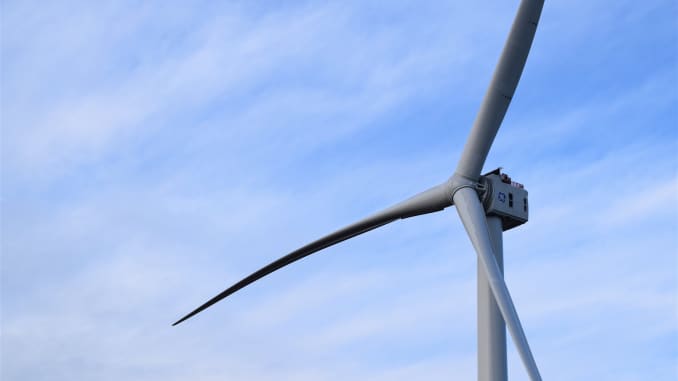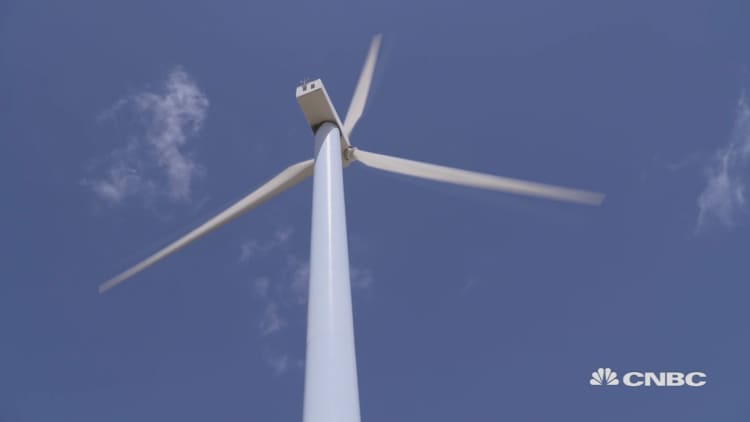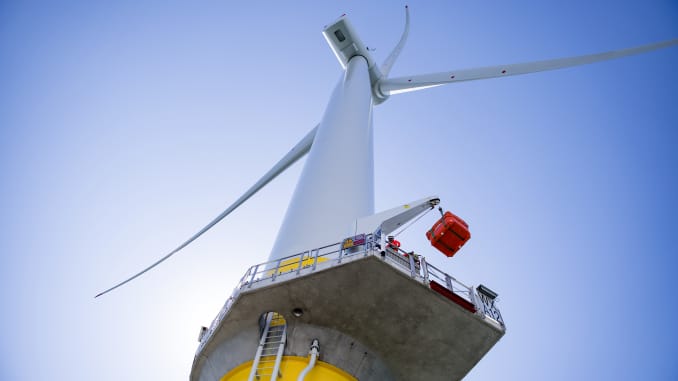NOT IN THE USA
PUBLISHED FRI, JAN 17 20201 Anmar Frangoul
KEY POINTS
Dogger Bank Wind Farms will be made up of three 1.2 gigawatt offshore sites.
The construction work is being carried out by a firm headquartered in North Wales.

GE’s Haliade-X wind turbine has a 12 megawatt generator and stands 260 meters tall.
GE Renewable Energy
Construction work for a huge offshore wind farm in the North Sea is underway.
In an announcement Friday, energy firm SSE said that onshore work for the 3.6 gigawatt (GW) Dogger Bank Wind Farms project had begun near Ulrome, a coastal village in the East Riding of Yorkshire, England.
Dogger Bank Wind Farms – which SSE described as “the world’s largest offshore wind farm” – will be made up of three 1.2 GW offshore sites: Creyke Beck A, Creyke Beck B and Teesside A. The project is a joint venture between SSE Renewables and Norwegian energy major Equinor.
The construction work is being carried out by Jones Bros Civil Engineering U.K., a firm headquartered in North Wales.
The scheme is set to use GE’s Haliade-X wind turbine, which has a 12 megawatt generator and stands 260 meters tall. According to SSE, the project will have the capability to produce enough renewable energy for more than 4.5 million homes per year.

The future of wind turbines could be bladeless
“Getting the first spade in the ground is a significant milestone on any project, but for what will be the world’s largest offshore wind farm, this is a major moment for a project that has already been over a decade in the making,” Steve Wilson, who is managing director of Dogger Bank Wind Farms, said in a statement.
The U.K. is a major player in the offshore wind sector. It is home to projects such as the 659 megawatt Walney Extension facility, in the Irish Sea, which was officially opened in 2018.
The scale of that project is considerable: it is capable of powering more than 590,000 homes, has 87 turbines and covers an area of around 20,000 soccer pitches, according to Danish energy company Orsted.
Europe as a whole is home to a significant offshore wind sector. According to industry body WindEurope, 409 wind turbines were connected to the grid in 2018. The average size of offshore turbines in 2018 was 6.8 MW, which represents a 15% rise compared to 2017.
PUBLISHED FRI, JAN 17 20201 Anmar Frangoul
KEY POINTS
Dogger Bank Wind Farms will be made up of three 1.2 gigawatt offshore sites.
The construction work is being carried out by a firm headquartered in North Wales.

GE’s Haliade-X wind turbine has a 12 megawatt generator and stands 260 meters tall.
GE Renewable Energy
Construction work for a huge offshore wind farm in the North Sea is underway.
In an announcement Friday, energy firm SSE said that onshore work for the 3.6 gigawatt (GW) Dogger Bank Wind Farms project had begun near Ulrome, a coastal village in the East Riding of Yorkshire, England.
Dogger Bank Wind Farms – which SSE described as “the world’s largest offshore wind farm” – will be made up of three 1.2 GW offshore sites: Creyke Beck A, Creyke Beck B and Teesside A. The project is a joint venture between SSE Renewables and Norwegian energy major Equinor.
The construction work is being carried out by Jones Bros Civil Engineering U.K., a firm headquartered in North Wales.
The scheme is set to use GE’s Haliade-X wind turbine, which has a 12 megawatt generator and stands 260 meters tall. According to SSE, the project will have the capability to produce enough renewable energy for more than 4.5 million homes per year.

The future of wind turbines could be bladeless
“Getting the first spade in the ground is a significant milestone on any project, but for what will be the world’s largest offshore wind farm, this is a major moment for a project that has already been over a decade in the making,” Steve Wilson, who is managing director of Dogger Bank Wind Farms, said in a statement.
The U.K. is a major player in the offshore wind sector. It is home to projects such as the 659 megawatt Walney Extension facility, in the Irish Sea, which was officially opened in 2018.
The scale of that project is considerable: it is capable of powering more than 590,000 homes, has 87 turbines and covers an area of around 20,000 soccer pitches, according to Danish energy company Orsted.
Europe as a whole is home to a significant offshore wind sector. According to industry body WindEurope, 409 wind turbines were connected to the grid in 2018. The average size of offshore turbines in 2018 was 6.8 MW, which represents a 15% rise compared to 2017.










